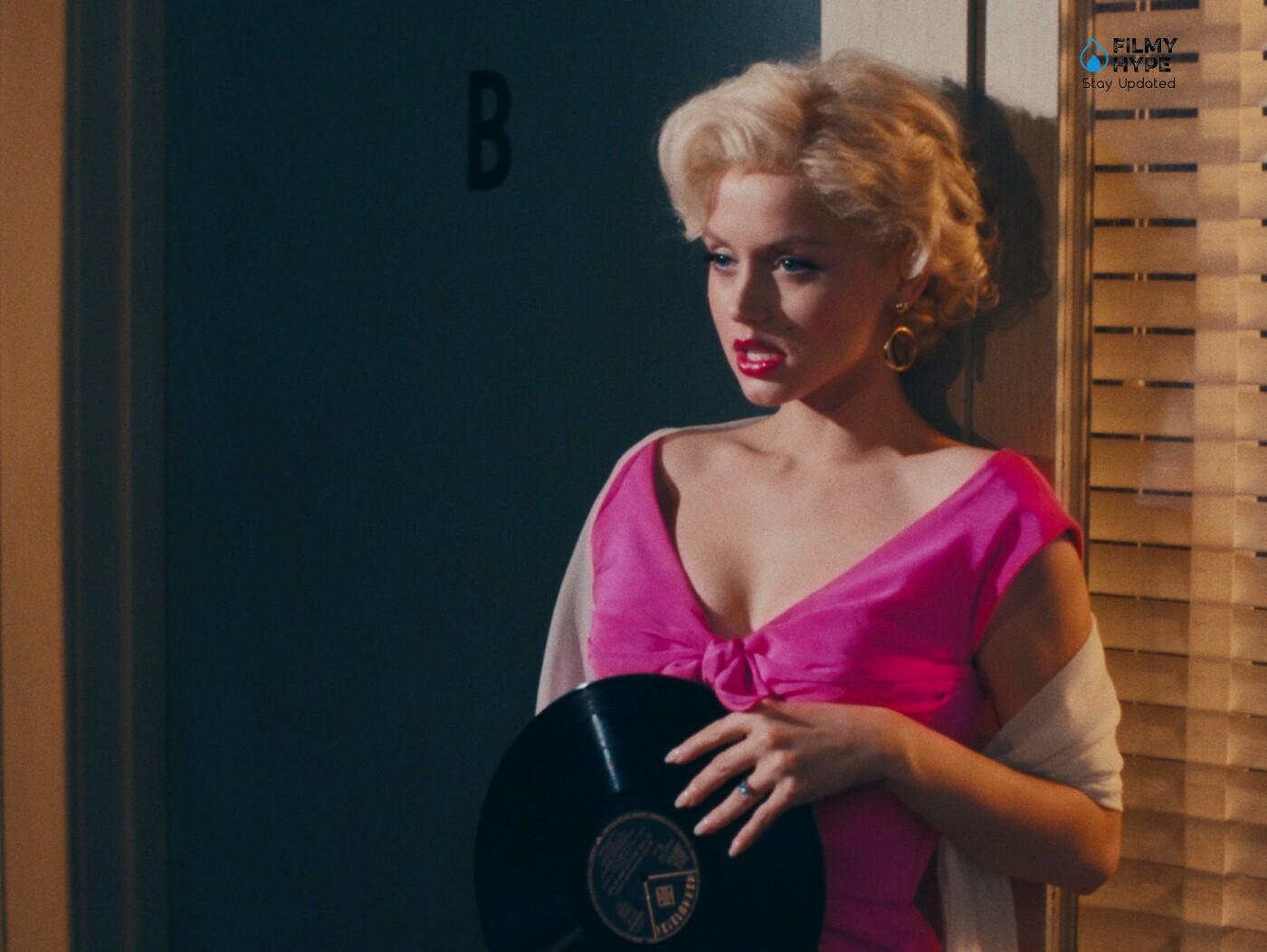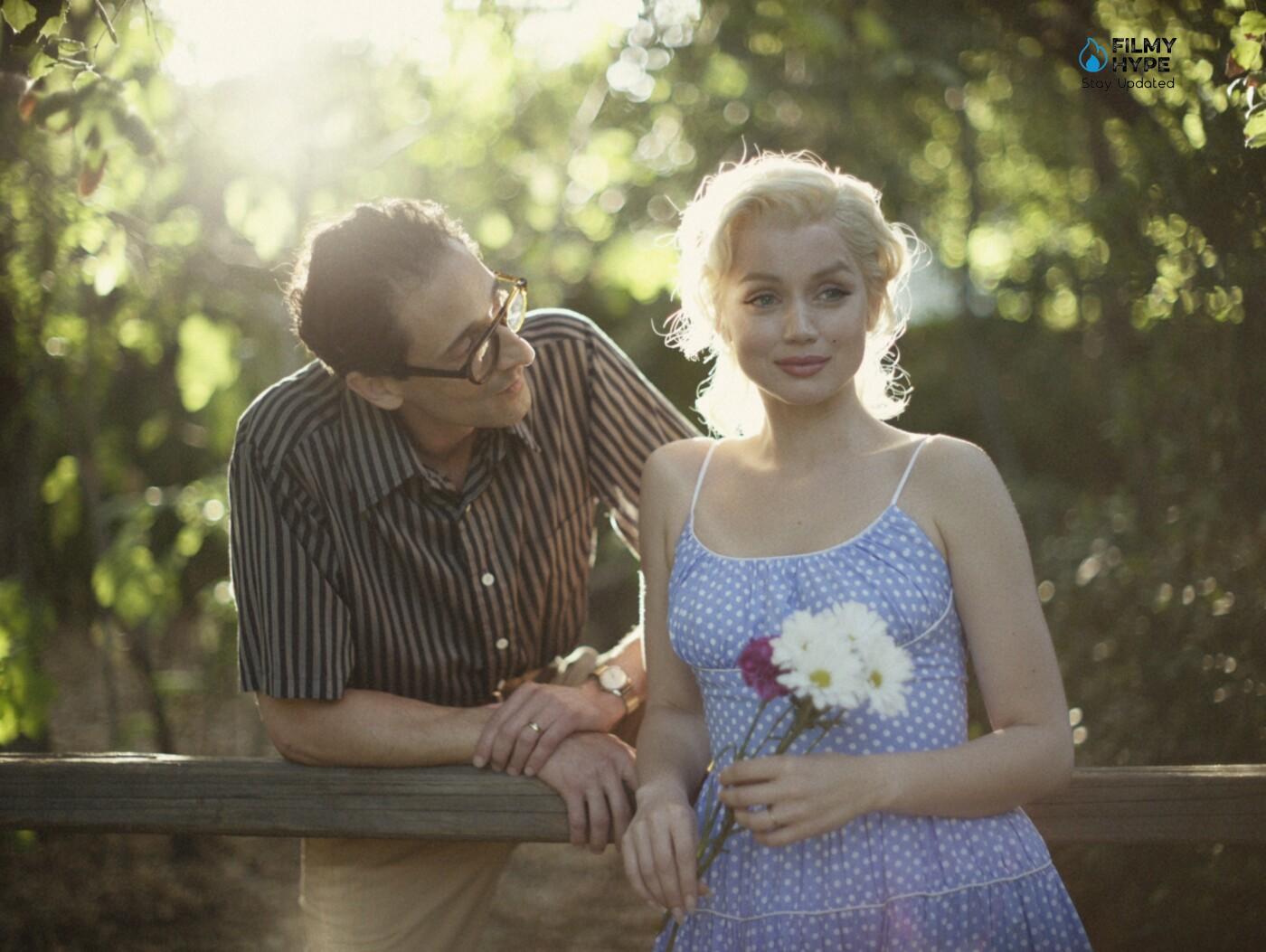Blonde Review: Between The Flesh And The Folds Of A Lacerating Existence (Venice 79)
Cast: Ana de Armas, Adrien Brody, Bobby Cannavale, Julianne Nicholson
Director: Andrew Dominik
Filmyhype.com Ratings: 4/5 (four stars) [yasr_overall_rating size=”large”]
After ten long years of absence from the big screen, Andrew Dominik returns to the cinema with the highly anticipated Blonde, a fabulous reworking of Joyce Carol Oates ‘ novel of the poignant story of Marilyn Monroe, here played by a wonderful Ana de Armas. From an unwanted child to an icon idolized by millions of people, passed from hand to hand, desperately looking for someone to call “Dad”, Norma Jean fell into the abyss of self-destruction, killed, perhaps, by our gaze. Also starring are Adrien Brody, Bobby Cannavale, Xavier Samuel, Julianne Nicholson and Lily Fisher.

We can’t help but start our review of Blonde with these images, the same ones that open Andrew Dominik’s film, presented in competition at the Venice Film Festival 2022 (from September 28 on Netflix). A film that will cause discussion and that will divide a lot, totally anarchic in the staging, as elusive as the character it tells, as hard as the voyeuristic gaze we offer it. A long and slow funeral march that will allow us to enter the suffering head of Marilyn Monroe. And by Norma Jean. One and twofold, the character and the person. The untouchable diva and the fragile woman. The femme fatale and the victim.
Blonde Review: The Story
Blonde is not a biopic in the traditional sense of the word. It tells the life of Marilyn Monroe, from her relationship with her mother, depressed and violent about her, during the years of her childhood until her death in 1962 in circumstances not yet fully understood. Between her, her two marriages, the first with Joe DiMaggio, the second with Arthur Miller, her consecration as a movie star, and her decline due to psychotropic drugs. But it is above all the story of how Norma Jean, the actress’s real name, feels, of how she is observed, of how she is plagiarized, of how the stage name Marilyn Monroe gradually devours all sanity of her. And the source material could not be otherwise seen, Joyce Carol Oates’ novel of the same name which constructed through fiction a controversial portrait of Monroe. Sacrificing the chronicle of events, but focusing solely on the protagonist’s “empire of the mind”, Blonde does not want to be a conventional biographical story, but a reinterpretation of a human condition, which evolves and sinks over time.
Starting with a sensational beginning, in which Norma Jean celebrates her birthday, and then embarking on a drive away with her mother, increasingly nervous and depressed for having lost her husband, while the hills of Hollywood (land) burn. They burn like the anger of a mother who makes her failures fall on her daughter, who will spend her life carrying this increasingly painful weight on her, in constant search for love. Having lost her mother figure, Norma has nothing to do but look for the love of her father, never seen before except in a photograph. A search for her that will transform her more and more into a piece of meat, into a dish to be delivered and abused, a body to be observed and mythologized. It is the birth of Marilyn, a luminous alter ego that hides enormous darkness. From then on, the events will follow one another.
Blonde Review and Analysis
From the beginning, the film focuses on the inner world of Norma Jean/Marilyn Monroe, relegating to the background everything that does not belong to the emotional sphere of the protagonist and not caring about explaining her life in detail. Indeed, very often the feeling is that the context in which the scenes are shown is taken for granted as if the viewer should already know everything about the American diva. This is not in itself a real flaw (since this is not the focus of the film), but it could confuse the reading of the individual scenes and the approach with which the public interfaces in the vision of this nightmare. We do not use the term “nightmare” inappropriately, because the suspended and distorted dimension of the film entangles the viewer in a dreamlike and painful abyss, in which rational consequentiality often loses its meaning. We find ourselves inside Norma’s unconscious, the sacrificial victim of a society that exchanges talent with the “beautiful ass”, with its paranoia, suffering, and desires.
The result is a film that drags the viewer into an anarchic whirlwind of styles. The format changes seamlessly between 4: 3, the 1950s Academy ratio and panoramic; black and white and color alternate, sometimes following a division between the character of Norma and that of Marilyn, sometimes based only on an aesthetic beauty that strikes almost three hours of duration. The style of Dominik, a director who, thanks to the availability of Netflix, was able to create an art film without compromise, becomes fluid and unpredictable: action cams, drones, hand-held cameras, vertical shots, fades that combine reality with fantasy, montage detachments that link the earthly dimension with the cosmic one, there is everything and more. A baroque and sometimes excessive style, even at the risk of going beyond the boundaries of the acceptable, will certainly provoke the viewer’s nerves and may even annoy him, but it is perfectly functional to the inner dimension of the constant suffering character.
As Richard Dyer carefully analyzes in his essay on stardom Star, and director Andrew Dominik transposes on the screen, the image of Marilyn Monroe is to be placed in the current of ideas on morality and sexuality of the American 1950s: years of the affirmation of a star ” rebels ”such as Marlon Brando, James Dean and Elvis Presley period of diffusion of Freudian concepts after the war and of attenuation of film censorship in the face of competition with television; but also years of social, sexual and economic tensions. The icon, the character of Marilyn, managed to condense sexuality and innocence through a unique charisma, and seemed to personify the tensions that ran through the ideological life of the time: a heroic survival of tensions or a painful exposition of them? Andrew Dominik’s work tries to combine both questions.
Although Andrew Dominik has accustomed us to an always very elegant display of pain, here the director leaves the reins of the story in Norma’s hands, making her dream and scream at the same time, letting her choose the colors she prefers most to paint or review some memories. A circle of light that contains an alternative self to carry with you wherever you go: we are not just talking about an Actors Studio exercise taught to Norma, but of a real light that will always tend to pursue – sometimes it will overwhelm her even in the imagination – to remind her of the terrible condemnation with which she will always have to deal: to be something else for those who do not know us, to assume meanings that we do not feel ours, take refuge in a scary mask because it is what is required.

In Blonde, we spectators will never be the ones to see Marilyn, to view the fragments of iconic sequences taken from her most successful films: of this, Andrew Dominik, only the audience of the theaters of those years participates in, masses of admirers dazzled by an inseparable and suffering pact between the cinematographic reflection and the dramatic caliber that every debilitated existence brings with it. We have the privilege of reaching out to Norma Jean, remembering her beyond the myth, her icon. Beyond the barriers that Andrew Dominik crosses in the name of the reworked fiction, to remind us that blond is a mask but, sometimes, it can also be light: to save Norma.
It is a film steeped in death, Blonde, starting from the title that takes away the personal and identity character of the character to it. Blonde not Norma or Marilyn. The container of dreams for the average American, the product built for the consumer. Norma dies constantly: she dies in the absence of affection and in the abuse she suffers, she dies with every applause they give her, she dies every time a man doesn’t believe in her intelligence. She dies at every glance, especially males, towards her. Which is ours too. If cinema is the place where desire is projected through light, Blonde commodifies the myth of Marilyn by making us desire her suffering. Bathed in light, by her ethereal beauty, Norma welcomes our perverse gaze, which gives her strength and a sense of being, but on the other hand, weakens her identity more and more. The body dies, but the legend remains, like a ghost that only the screen can represent, as in the best horror tradition.
Blonde Review: The Last Words
Blonde is a film that will divide the audience a lot, with an anarchic style and with several moments at the limit of endurance. Yet, thanks to an Oscar-winning interpretation by Ana de Armas, she manages to represent the interiority of Marilyn Monroe (between reality and fiction) with a taste that leaves no one indifferent, making it one of the most provocative and theoretical films of the Venice competition 79. In Blonde, we viewers will never be the ones to see Marilyn, to view the fragments of iconic sequences taken from her most successful films. We have the privilege of reaching out to Norma Jean, remembering her beyond the myth, her icon. Beyond the barriers that Andrew Dominik crosses in the name of the reworked fiction, to remind us that blond is a mask but, sometimes, it can also be light: to save Normal.




